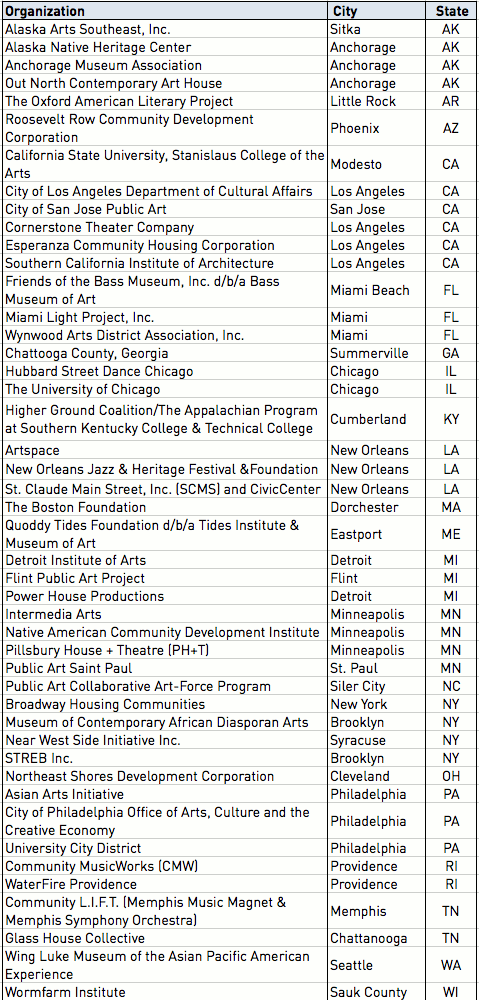
Horst von Harbou. "Metropolis" by Fritz Lang.
Can Creative Placemaking Be Proven? The (New) State of the Arguments
It’s become a trope of creative placemaking, one of the most discussed new forms of art funding that I reported on last October for New Formula, that arts “assets” can transform, vitalize and invigorate future economic development. But is this true? Is there proof? This line of questioning has been very active – indeed hot – in the philanthropic and arts-analytic blogosphere in the past few months.
The idea of creative placemaking historically hinges on the thinker-pundit-Atlantic Cities editor named Richard Florida who coined the terms creative cities and creative class; and who founded his consultancy, CreativeClassGroup to consult to cities aspiring to be “creative” when The Rise of the Creative Class, his book that started the movement, first came out. (Carol Coletta, who heads ArtPlaceAmerica and who described “vibrancy” to me last year, was a 2003 co-organizer of Memphis’s Manifesto Summit, an event in large part inspired by The Rise of the Creative Class, that invited mayors and policymakers and Richard Florida, to a meeting that argued that things that come with creatives – parks, tolerance, artists, bohemians, spirituality, diversity and farmers’ markets – will ensue in economic good, too.
The book’s 10th-anniversary edition published this summer, occasioning a new flurry of commentary and dissent. Creative Santa Fe sponsors a free event on creative placemaking (with a speaker from the NEA) on August 3d, at 5:30 p.m. at the New Mexico History Museum Auditorium.
Among the best blogosphere thinkers and writers on creative placemaking, is Ian David Moss of FracturedAtlas, and his blog, CreateQuity.com, a highly trusted source. [See These Excellent Links: May 9, 2012: Creative Placemaking Has an Outcomes Problem and July 17, 2012: Richard Florida Redux and the Creative Placemaking Backlash]
Two national entities have thrown weight behind creative placemaking. The National Endowment for the Arts, which funds “creative placemaking” projects dedicated to improving the “liveability of communities”, under the “Our Town” moniker. On the private side, ArtPlaceAmerica, is a consortium of very big private US foundations (with no federal money contributed) which on June 12th this year, announced the second round of grants: $15.4 million going to 47 new projects nationwide. (Some 2200 letters of interest were submitted. None of Santa Fe’s proposals made it to the finalists. See the full link here to winners in categories including “Using Art to Bring New Life to Rural Communities;” “””To Create Civic Brand Stories;” “”””Spark Redevelopment.”)
Throughout, bloggers and wonks have grown more insistent, on whether creative placemaking actually has generated economic outcomes. Moss says the questions have led the policymakers to break out in hives, and social-scientise research is under way. The NEA led a webinar on so-called vibrancy indicators related to Our Town (The Our Town Community Indicators Study), in April.
ArtPlaceAmerica, has said it is working on figuring out “indicators” but has thus far only detailed “10 signals”, questions with yes or no answers, as to whether creative placemaking is actually transforming communities (the yes-or-no questions include: “Does the neighborhood feel safer? Is the neighborhood more attractive? Is there a popular new indoor/outdoor gathering place? Has the local press reported on it positively? Do people in the neighborhood generally agree that the neighborhood is getting better?”).

Drive-In, a project of Ballroom Marfa, has been envisioned as improving Vizcaino Park in Marfa. A partnership between Presidio County officials and Ballroom Marfa was in the news in March 2011, but the status of the development now is not known.
The ArtPlaceAmerica signal questions are, as you can see, qualitative and largely subjective. NEA’s deputy research director Steven Shewfelt, meanwhile, said at the NEA’s April webinar that NEA has come up with a set of hypotheses, that it wants to put under the microscope.
One of those hypotheses, he said, is that creative placemaking leads to increased business- and home-property values. “Data-mining the arts,” is, Shewfelt said, part of the goal.
Let’s just repeat that: Data-mining the arts.
While looking at increases in home- or business-property values related to arts assets seems like an interesting idea, some of the critics are basically arguing research: how precisely are researchers going to know that the specific and exact arrival of an arts organization was the thing that directly (or exclusively?) brought about the increase? If a test-able hypothesis goes back into subjective reporting on “signals,” will it really be possible to correlate increased property value, with arts assets? Especially, over time, and in an extrapolable way.
In other words, say the critics, many creative placemaking adherents are guilty of magical thinking. They argue that causality between arts assets in “creative cities” and economic development, is hooey.
Frank Bures, a freelance writer in Madison, WI, has had a vivid back-and-forth with Richard Florida after writing a post, The Fall of the Creative Class, on June 15th for thirtytwomag.com in which he contends Florida was “wrong..about Madison.. and about everything.” (Link here.)
Bures cites both European and domestic studies: “Accommodating Creative Knowledge”– a four-year, $6 million study of thirteen cities across Europe that found the migration of creative workers to places that are tolerant, open and diverse—was simply not happening.” He also quotes a Washington State University political scientist who put Florida’s 1990-2008 data to a test and concluded, “The measurement of the creative class that Florida uses in his book does not correlate with any known measure of economic growth and development.”
Bures himself can’t quite resist some “qualitative” exemplifying: In the form of one “Penelope Trunk,” who left Madison after a few years but was
a ruthless, relentless self-promoter. Trunk’s name was splashed across the papers, and seemed to confirm every Floridian suspicion. Local capitalists bankrolled her new company, Brazen Careerist. She blogged and blogged and blogged about how best to choose the place to work and live. She was an apostle of Floridian doctrine and flew around giving speeches about how places could attract the shock troops of the creative economy the way Madison had attracted her.”
The continual subhead of Bures’s article:
What was missing was any actual proof that the presence of artists, gays and lesbians or immigrants was causing economic growth.
(Bures writes in a more recent blog post just last week that many people responded to his June post saying it was “depressing.”)
Moss’s reporting indicates how ultimately, all paths lead back to Florida – and Florida is definitely here to stay, maybe because whether the thinking is magical or not, we all like the way that, for example, the website Atlantic Cities, prognosticating everything from “creative cities” to “the geography of bars and restaurants,” can make us feel like we’ve chosen wisely, the where-to-live question?)
What’s really interesting is how hotly debated arts’ relationship to economic transformation is, as an ongoing experiment in which it seems like, all that can be known, is that artists while contributing a lot to any community, have never been harbingers of supersize prosperity. As far as cities and policies go, Ian David Moss describes a conversation with Richard Florida’s right-hand man at the University of Toronto business school, Kevin Stolarick, who told him:
the book’s success (in 1992) led to an explosion of interest from mayors all around the country wanting to redefine their cities as welcoming meccas for Florida’s new Starbucks-drinking, jeans-wearing idea people. Unfortunately, the mayors’ collective interpretation of the lessons from Florida’s book boiled down to, “all we need is to get us some gays and artists and a bike path or two, and our problems will be solved! The problem,” Stolarick tells us, a decade after The Rise of the Creative Class’s publication, “is that it’s a trap.”
We’ve managed at the end of the day not to inquire as hard as we might of our cities about the policies they’re pursuing independent of bike paths, and I remain deeply convinced that unless Santa Fe gets truly fully informed on all sides of the arguments about whether arts assets cause prosperity, we’ll just keep talking in circles. (After all, Santa Fe was one of the earliest adopters of arts assets outsized to the size of the city, yet meanwhile, its biggest industry remains tourism rather than locally thriving business. The recent news that the city Economic Development department had failed to distribute more than $360k in funds in the fiscal year just ended, with the astonishing headline “City Saves $362k..” will be the subject of a future post.)
I hope readers will write in about this Friday’s presentation, and whether it delved into the controversies that count among the ways serious people are talking about creative placemaking the country and world over. Projects funded by ArtPlaceAmerica in this second round, below:

